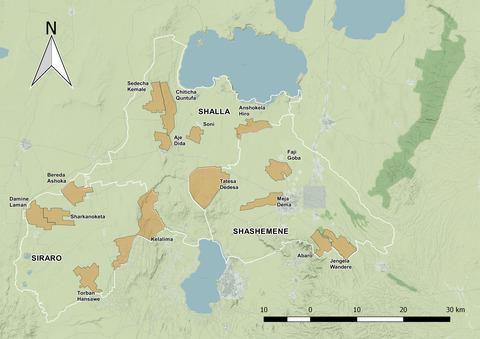Our official English website, www.x-mol.net, welcomes your
feedback! (Note: you will need to create a separate account there.)
Analysis of gender vulnerability to climate‐related hazards in a rural area of Ethiopia
The Geographical Journal ( IF 3.6 ) Pub Date : 2019-08-23 , DOI: 10.1111/geoj.12321 Elena Belcore 1 , Alessandro Pezzoli 1 , Angela Calvo 2
The Geographical Journal ( IF 3.6 ) Pub Date : 2019-08-23 , DOI: 10.1111/geoj.12321 Elena Belcore 1 , Alessandro Pezzoli 1 , Angela Calvo 2
Affiliation

|
Identifying areas of the world, communities, and women and men that could be damaged by meteorological events (like droughts and floods) has been crucial for vulnerability studies in the last decade. Climate change may differently affect female‐ and male‐headed households, especially in rural areas of sub‐Saharan Africa, where they react in a different way to the effects of adverse weather events. The aim of this work was to analyse a population's vulnerability and resilience to climate‐related hazards, applying a sex‐disaggregated, quantitative methodology at household level. This study was realised in three Woredas (Siraro, Shalla, and Shashemene) of the Oromia Region in Ethiopia. The information used for the evaluation included climatic conditions, socio‐economic variables and natural resource availability. All data collected were analysed after disaggregation by sex. Evaluation of the indices shows that the vulnerability of the households is particularly related to the presence of governmental infrastructure, availability of water sources, and external aid. The study reveals that the Woreda of Siraro is the most vulnerable. A better situation appears in the Woredas of Shalla and Shashemene, where women and men have more skills to face vulnerability, as highlighted by the “recovery potential” index. On the other hand, the study points out some differences between women and men. While male‐headed households mainly have low vulnerability and high resilience, female‐headed households are divided into two main classes: low vulnerability associated with low resilience, and low vulnerability associated with high resilience. When the vulnerability is higher, both women and men show higher resilience.
中文翻译:

埃塞俄比亚农村地区性别易受气候相关危害的影响分析
在过去的十年中,确定世界上可能受到气象事件(例如干旱和洪水)破坏的地区,社区以及男女,对于脆弱性研究至关重要。气候变化可能对以女性为首的家庭和以男性为首的家庭产生不同的影响,特别是在撒哈拉以南非洲的农村地区,他们在恶劣天气事件中的反应方式不同。这项工作的目的是在家庭一级采用按性别分类的定量方法,分析人口对气候相关危害的脆弱性和适应力。这项研究是在埃塞俄比亚奥罗米亚地区的三个Woredas(Siraro,Shalla和Shashemene)中实现的。评价所用的信息包括气候条件,社会经济变量和自然资源的可获得性。按性别分列后,对收集到的所有数据进行分析。对各项指标的评估表明,家庭的脆弱性尤其与政府基础设施的存在,水资源的可获得性和外部援助有关。研究表明,西拉罗(Siraro)的后卫是最脆弱的。“恢复潜力”指数突显了在沙勒(Shalla)和Shashemene州(Woredas)出现的一种更好的情况,那里的男女有更多面对脆弱性的技能。另一方面,研究指出了男女之间的一些差异。以男性为户主的家庭主要具有较低的脆弱性和较高的适应力,而以女性为户主的家庭则分为两大类:与较低的适应力相关的低脆弱性和与较高的适应力相关的低脆弱性。
更新日期:2019-08-23
中文翻译:

埃塞俄比亚农村地区性别易受气候相关危害的影响分析
在过去的十年中,确定世界上可能受到气象事件(例如干旱和洪水)破坏的地区,社区以及男女,对于脆弱性研究至关重要。气候变化可能对以女性为首的家庭和以男性为首的家庭产生不同的影响,特别是在撒哈拉以南非洲的农村地区,他们在恶劣天气事件中的反应方式不同。这项工作的目的是在家庭一级采用按性别分类的定量方法,分析人口对气候相关危害的脆弱性和适应力。这项研究是在埃塞俄比亚奥罗米亚地区的三个Woredas(Siraro,Shalla和Shashemene)中实现的。评价所用的信息包括气候条件,社会经济变量和自然资源的可获得性。按性别分列后,对收集到的所有数据进行分析。对各项指标的评估表明,家庭的脆弱性尤其与政府基础设施的存在,水资源的可获得性和外部援助有关。研究表明,西拉罗(Siraro)的后卫是最脆弱的。“恢复潜力”指数突显了在沙勒(Shalla)和Shashemene州(Woredas)出现的一种更好的情况,那里的男女有更多面对脆弱性的技能。另一方面,研究指出了男女之间的一些差异。以男性为户主的家庭主要具有较低的脆弱性和较高的适应力,而以女性为户主的家庭则分为两大类:与较低的适应力相关的低脆弱性和与较高的适应力相关的低脆弱性。











































 京公网安备 11010802027423号
京公网安备 11010802027423号